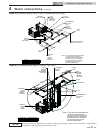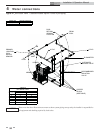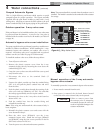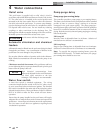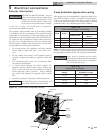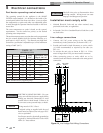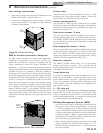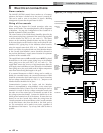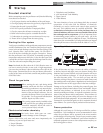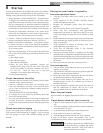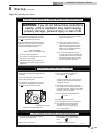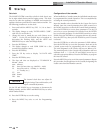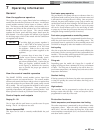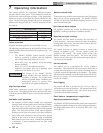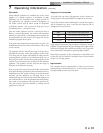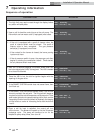
45
6 Startup
Installation & Operation Manual
Check/control water chemistry
Salt levels above 5000 ppm can cause
corrosion damage to heat exchangers.
ƽ CAUTION
The water chemistry of your pool changes daily due to natural
evaporation of the water and the addition of chemicals.
Chemicals are used to sanitize and control algae growth in
the pool. Their addition must be carefully monitored. The
accumulation of minerals or scale in the pool heater due to a
chemical imbalance will cause a non-warrantable failure of the
heat exchanger and its components. pH is an important factor
in maintaining proper balance in your pool water. pH is the
measurement of the acidity or alkalinity of water. The following
chart shows the recommended pH range and what can happen
when the pH increases or decreases from the ideal of 7.2 to 7.8.
Figure 6-1_ pH Scale
If the pH becomes too high, it lowers the ability of chlorine
to destroy bacteria and algae, water can become cloudy, filter
elements may become blocked, and scale formation will occur
in the pool and heat exchanger. If the pH becomes too low
the water becomes acidic. You can have eye burn and skin
irritation, etching of the plaster, corrosion of metal fixtures and
the resulting stains on the plaster, degradation of sand and gravel
filters and corrosion of the copper tubes in the heat exchanger.
Factors which affect pool water and, more importantly, the
efficiency of your new pool heater are:
1. Proper Filtration
2. Proper Circulation
Before starting the unit, and during initial
operation, smell near the floor and around
the unit for gas odorant or any unusual odor.
Remove the front access panel and smell the
interior of the pool heater enclosure. Do not
proceed with startup if there is any indication
of a gas leak. Use an approved leak detection
solution. Repair any leaks at once.
ƽ WARNING
Check for gas leaks
Pre-start checklist
Before attempting to start the pool heater verify that the following
items have been checked:
1. Verify proper location and installation of the pool heater.
2. Check gas piping and ensure the gas line is purged of all air.
3. Ensure that the pool is properly filled.
4. DO NOT operate pool heater if improperly filled.
5. Check to ensure that all water connections are tight.
6. Relief valve has been piped to a suitable floor drain.
7. Combustion air openings are not obstructed in any way.
8. Ensure all air is purged from the water piping.
Starting the filter system
Verify proper installation of the pool heater temperature controls
and the installation of the 110°F auxiliary limit and pool supply
sensor in the mixed discharge water from the filter piping to the
pool. Clean the filter. Start the filter pump. Be sure all air is
out of all the lines including the pressure connection. Ensure
that the pool heater is not “air bound” by manually opening the
temperature and pressure relief valve. Leave the valve open until
a steady flow of water is observed at the discharge from the valve.
Close the valve and complete filling the system.
Note: Backwash the filter when the G.P.M. filtration rates are
too low to meet local codes or state code. A high temperature
rise across the pool heater is also an indication of low flow in the
filter system. Sustained low flow to the pool heater will result in
cycling of the heater on the limit controls and possible opening
of the relief valve.
Damage to the pool heater, including the pumped bypass, due
to improper chemical water balance is non-warrantable. Proper
chemical water balance, as indicated by use of the calcium
saturation and Ryznar indexes, is required to maintain warranty
status of the pool heater and its components. These indexes are
designed to help prevent scaling and corrosive damage to the
pool and all associated equipment. We recommend the use of a
commercial or professional grade test kit to maintain chemical
water balance. See your local pool professional for assistance.
The venting system must be installed so that
it will prevent flue gas spillage and carbon
monoxide emissions, which will result in
severe personal injury or death.
ƽ WARNING
3. Disinfection and Oxidation
4. pH Control and Total Alkalinity
5. Algae Control
6. Water Balance
Although this pool heater is CSA design certified for outdoor
installations - such installations are not recommended in areas
where the pool heater will be operated in the winter months
and the danger of freezing exists. Proper freeze protection must
be provided for outdoor installations; pool heaters installed in
unheated equipment rooms or where temperatures may drop to
the freezing point or lower.
Freeze protection



